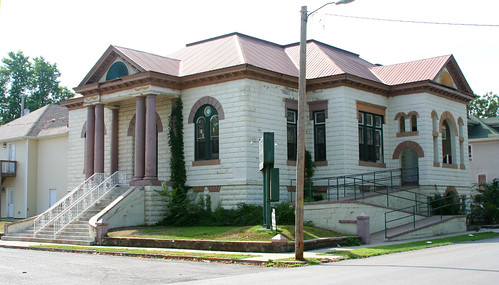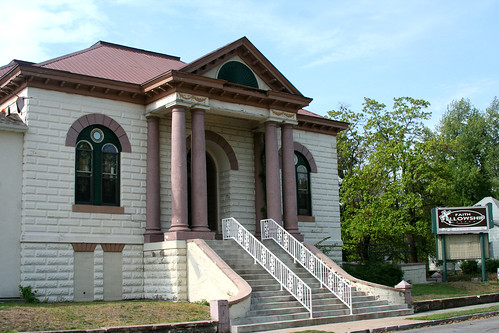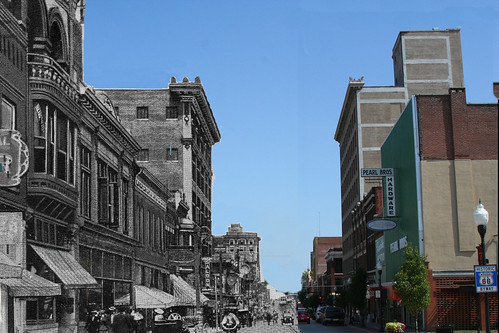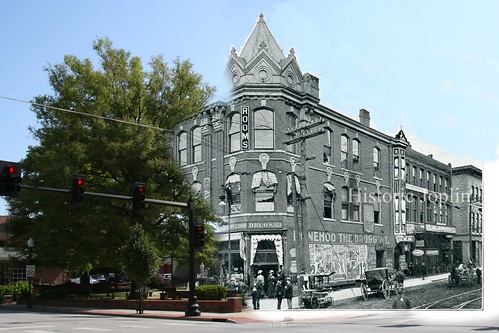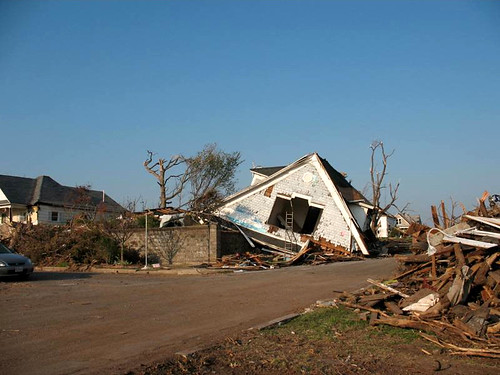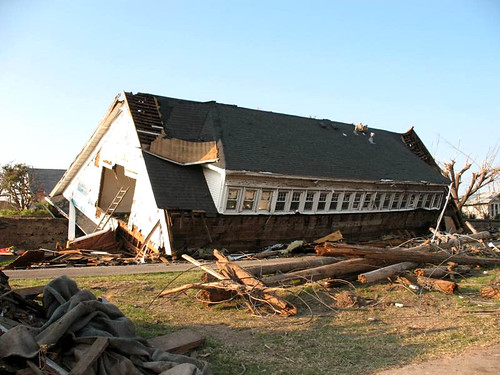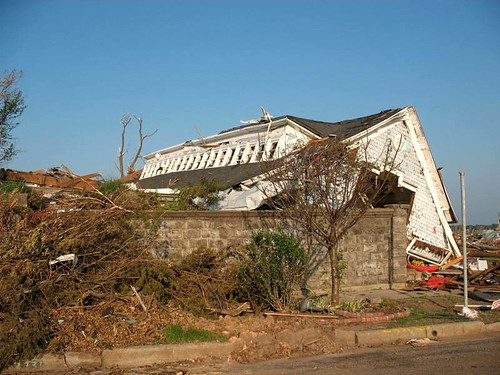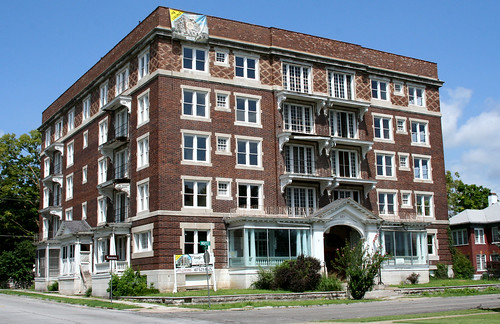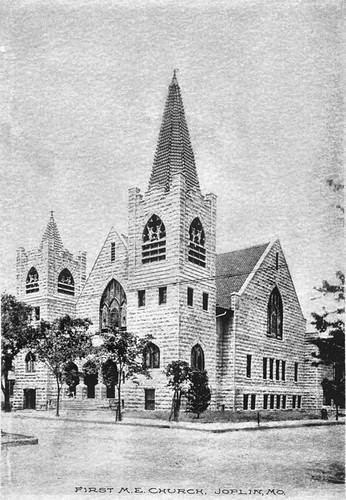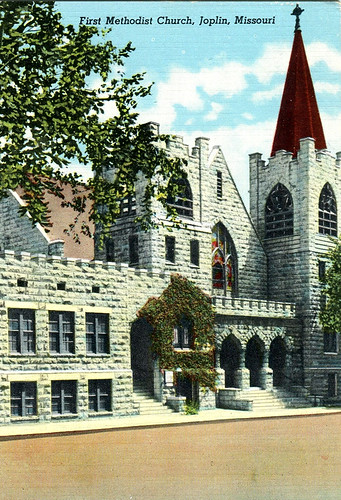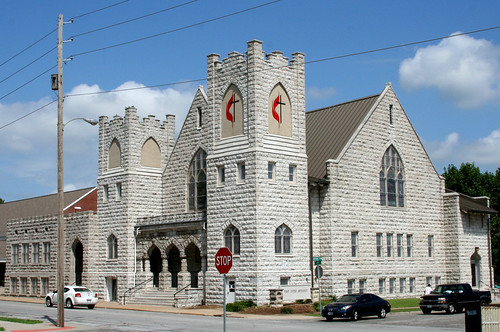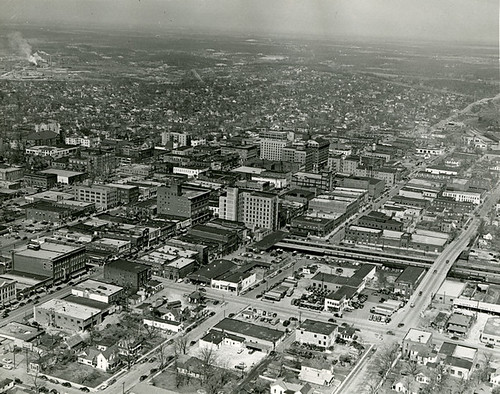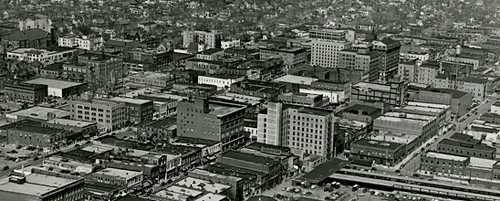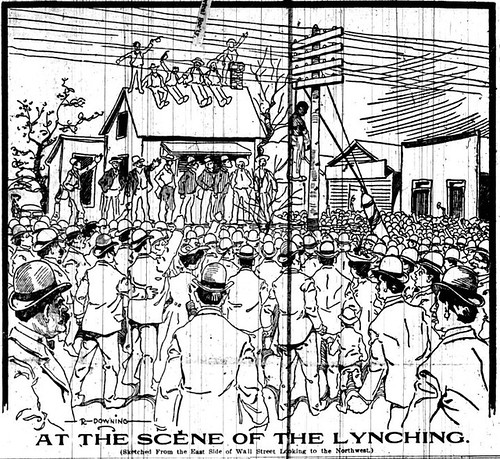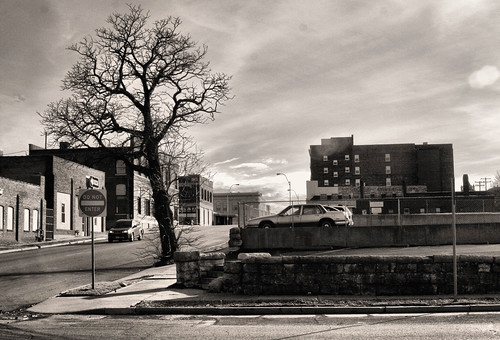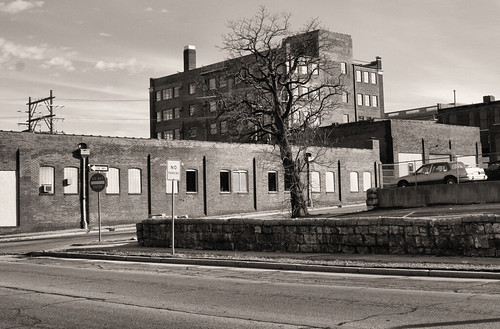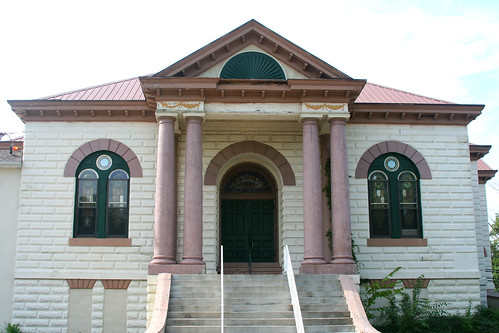
A drive past the intersection of 16th and Wall Street will take you by the First Church of Christ Scientist Church completed in 1906 and now the home of Faith Fellowship. A quick glance will also reveal a for sale sign next to the stately house of worship. It’s not often that 106 year old buildings in Joplin go up for sale, much less one that is a church. We took a few quick snapshots of the church and for those interested to learn a little more about the property, you can find the church’s listing right here.
First Church of Christ Scientists For Sale!
What If: Main Street Looking North
Brown, August 5th 2011 |Worth Block … What if?
Brown, July 21st 2011 |Baseball, Not Just For The Adults
While we’ve discovered the baseball in Joplin played by men who were paid, and by those who weren’t, the sport wasn’t limited to adults. In the below photograph, we’ve a team of boys, perhaps a high school team, who had banded together to form a formidable looking team. Who knows, perhaps one of them eventually found himself donning a Miners’ uniform.
Source: Historic Joplin Collection
Guest Piece: Chapters Erased from Joplin’s Architectural History – Leslie Simpson
CHAPTERS ERASED FROM JOPLIN’S ARCHITECTURAL HISTORY
By Leslie Simpson
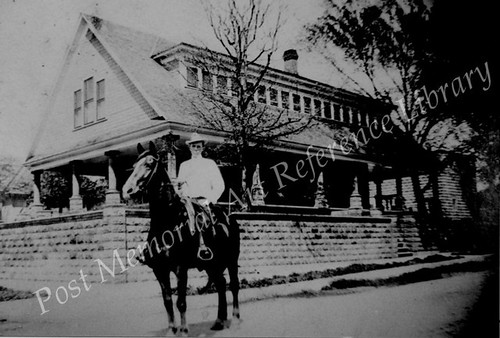
caption for photo: Carl Owen house at 2431 Porter. Built ca. 1911. Destroyed by tornado May 22, 2011 via Post Memorial Art Reference Library
I am having a difficult time knowing what to say. In fact, I hesitate to even write anything about brick and mortar, when human life, hopes, and dreams are what really matter. However, since I have written so much about Joplin’s architecture through the years, I feel compelled to say something. I have had several CNN reporters contact me for interviews, but I have not wanted to talk to them. First of all, I had not personally seen all the damage. It is impossible to get around, and I did not want to get in the way of emergency workers nor be a voyeur. Secondly, I just did not think I could articulate what has happened to my beloved Joplin. So now I will attempt some general (and unofficial) impressions of Joplin’s historic identity and how this incomprehensible tragedy has affected it. Also, rather than catalog specific buildings that have been lost, I will focus on three historic residential areas.
I begin with the historic town of Blendville in southwest Joplin, which was established in 1876 as “Cox Diggings.” The prosperous little community incorporated as Blendville, so-named because of the huge amounts of zinc blende in the ground. Thomas Cunningham owned the residential area, which he divided into lots and sold at low rates so that miners could afford their own homes. The city of Joplin extended its streetcar line to Blendville, with lines going south on Main to 19th Street, west to Byers, south to 21st Street, west to Murphy, then south to 26th. In 1892, Joplin annexed the village. Thomas Cunningham donated “Cunningham Grove” as Joplin’s first city park. The tornado took out most of the original Blendville area, including Cunningham Park and the historic water plant with some of the original equipment preserved inside.

The next area of historic significance is “Schifferdecker’s First Addition”, a residential area developed in south Joplin beginning in 1900. The Joplin Globe referred to the area lying south of 20th Street and fronting on Wall, Joplin, and Main Street as “a beautiful new addition affording the most desirable building property” to be found anywhere in the city. A second addition continued development south of 20th on Virginia, Kentucky, and Pennsylvania Avenues as well as along 21st, 22nd, and 23rd Streets to the east and west. The residential district continued to expand to the south throughout the teens, twenties, thirties. The homes in the region ranged from high Victorian styles to bungalows and eclectic Tudors, Colonial Revivals, Spanish mission, etc. Tragically, this charming old neighborhood has been wiped out.
After World War II ended, Joplin families faced a housing shortage. Some Camp Crowder buildings were moved to Joplin, while others were dismantled to provide construction materials. Hundreds of small efficiency houses were mass-produced for veterans and financed through FHA. Many of these were built in the Eastmoreland area. As people prospered in the 1960s and 1970s, they built more substantial brick homes east and south of the new high school at 20th and Indiana. Although most people do not think of these homes as historic, they do have their own place in Joplin’s architectural history, and their loss is devastating as well.
Entire chapters of Joplin’s history have been forever erased. I have not even touched on the loss of churches, schools, medical buildings, and businesses. Again, I am not relating the loss of our buildings to the loss of our people. Joplin will rebuild. It has already begun. During the first week after the tornado, I saw a business being rebuilt in the midst of the war zone surrounding West 26th Street!
Leslie Simpson, an expert on Joplin history and architecture, is the director of the Post Memorial Art Reference Library, located within the Joplin Public Library. She is the author of From Lincoln Logs to Lego Blocks: How Joplin Was Built, Now and Then and Again: Joplin Historic Architecture. and the soon to be released, Joplin: A Postcard History.
Restoring Joplin’s Memories
In the wake of Joplin’s tornado, homes were destroyed and the possessions within them literally scattered to the wind. While much that was lost, furniture or clothes, can be replaced in one way or another, photographs cannot. They are our way of capturing a moment in time be it a special event or simply the image of a loved one. If lost, there is no way to recapture with a camera that passing moment.
One such photographic horror story concerned the photographs of Murwin Mosler, who photographed Joplin and her people over a span of decades from the 1930s to the 1960s. Mosler’s life work, organized into a collection, was lost when the tornado destroyed his daughter’s home.
Some are not willing to let these lost photographs remained lost as numerous facebook sites, such as Joplin’s Found Photos, sprung up to attempt to reunite owners with their memories. In turn, a website, Joplin Rescued Photos, collects these links and offers to be a central location for the effort to save photographs and return them home. Joplin is not alone, either, as Operation Photo Rescue is on its way to the city sometime soon. Operation Photo Rescue consists of volunteers who will scan in damaged photographs, then digitally repair them and send the restored images to the owners for free.
While the days have passed since the storm and the clean up well under way, keep an eye open to a bent piece of paper lodged beneath a branch, it might well be someone’s memory and with the help of the people above, it might even find its way home.
The Olivia Apartments: Before and Now
One of the more luxurious apartment buildings in Joplin’s early history were the Olivia Apartments. The building was built in 1906 by Dieter and Wenzel construction firm on plans designed by one of Joplin’s widely used architects, Austin Allen. The man footing the $150,000 bill was Anton E. Bendelari, who had made his fortune in mining. The building was named for his daughter, Olivia. We’ll offer a more detailed history of the Olivia in the future, but for now here’s a look at the building’s past and its present (August 2010). As you may notice, while a survivor of over a 100 years, the Olivia has lost some of her exterior features.
Past and Present: First Methodist Church of Joplin
Home to one of Joplin’s oldest congregations, the First Methodist Church was built in 1905. Two years later, the church was host to one of Missouri’s greatest musicians, John William Boone, otherwise, and more popularly, known as “Blind Boone.” Below are three images of the church which approximately span the building’s 106 year history.
Joplin Before Urban Renewal
It is obvious to many the impact urban renewal had on Joplin’s downtown area. While the parking lots are many, many may not recall what once stood in those locations. In the photograph below, taken in 1955, we have a rare opportunity to see the downtown of Joplin right before the beginning of urban renewal in the following decade. See how many of the historic buildings you can spot. We’ll post again this weekend pointing out what is where.
Printed with permission from the State Historical Society of Missouri.
Feel free to click on the images for slightly bigger versions. Unfortunately, the internet publishing policy of the State Historical Society prevents us from offering larger versions.
Source: State Historical Society of Missouri
Second and Wall – Site of the 1903 Joplin Lynching
In anticipation of our coverage of the 1903 Joplin lynching, we bring you photographs of the location of the tragedy: Second and Wall. It was at this intersection that Thomas Gilyard was lynched from the arm of a telephone pole by a mob. First is a drawing of the lynching that was printed in the Joplin Globe immediately after the lynching. The artist was Ralph Downing, who later went on to be an artist for the Kansas City Star (where he worked the rest of his career).
The first photograph comes courtesy of the Post Memorial Art Reference Library and was taken just a couple months after the lynching, if not sooner.
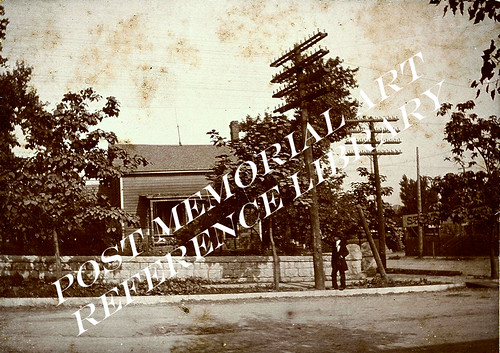
The back of the photo read, "Joplin, Mo. June 17, 1903. This is where Bro. C.H. Button and myself lodged at the home of Mr. Wilson. The telegraph pole is where a negro was mobbed and hung last spring. Taken by Prof. C.H. Button, J.R. Crank. Taken at Bible School Convention." Courtesy of the Post Memorial Art Reference Library, Joplin Missouri
The next photographs were taken just last month, December 2010. Regrettably, the time of day and the position of the sun got in the way of nailing a photograph from the exact same position. For identification purposes, the only surviving landmark from the gruesome moment is the stone retaining wall which you will find in all the images.
If you don’t want to wait to learn more about the lynching, you can read about it in White Man’s Heaven by Kimberly Harper or pick up the most recent edition of the Missouri Historical Review.
Sources: Post Memorial Art Reference Library, Joplin Daily Globe, White Man’s Heaven by Kimberly Harper, and Historic Joplin Collection.
